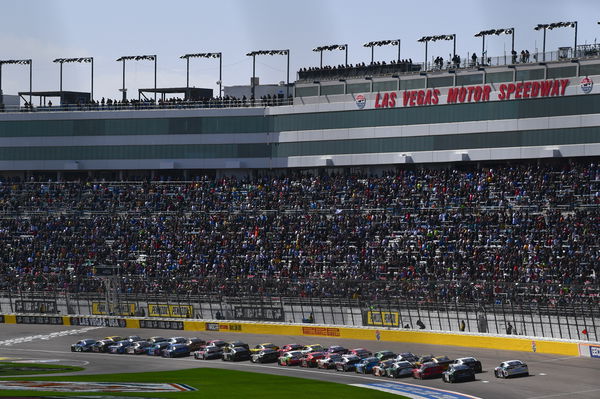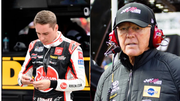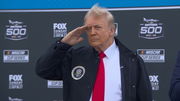
USA Today via Reuters
Mar 3, 2024; Las Vegas, Nevada, USA; NASCAR Cup Series driver Daniel Suarez (99) leads the field for the restart of the Pennzoil 400 at Las Vegas Motor Speedway. Mandatory Credit: Gary A. Vasquez-USA TODAY Sports

USA Today via Reuters
Mar 3, 2024; Las Vegas, Nevada, USA; NASCAR Cup Series driver Daniel Suarez (99) leads the field for the restart of the Pennzoil 400 at Las Vegas Motor Speedway. Mandatory Credit: Gary A. Vasquez-USA TODAY Sports
The Charlotte ROVAL played the eliminator in the round of 12, and Hendrick Motorsports almost had a historic finish. As the team owner, Rick Hendrick rejoiced at all his cars’ advancement to the next round, NASCAR pulled the plug on Alex Bowman. NASCAR disqualified the #48 after a splendid playoff run as his car failed the post-race weight inspection.
Bowman finished the race in 18th position, still managing enough points to progress in the top 8. However, the penalty ended his championship hopes and kept Joey Logano alive. Disqualifications in playoffs aren’t something new. However, some of the past data shows that Bowman’s case is unprecedented.
ADVERTISEMENT
Article continues below this ad
Alex Bowman’s DQ: A Historic Ruling
While teams are allowed to challenge NASCAR rulings, HMS opted to stay out of it as nothing conclusive was found in their internal inspection of the car that might have led to the weight reduction. The team, in their statement, said, “NASCAR allows a clear margin to account for the difference in pre- and post-race weight. After a thorough review by our team and the sanctioning body, we simply did not give ourselves enough margin to meet the post-race requirement. Although unintentional, the infraction was avoidable. We are extremely disappointed to lose a playoff spot under these circumstances and apologize to our fans and partners.”
This comes after NASCAR conducted thorough checks, including the buffer they give teams. Yet the weight of the car was significantly less than the pre-race measurements. While all is done and dusted with Alex Bowman‘s chances to continue in the playoffs, some past data on disqualifications in the playoffs have revealed Bowman’s case as one of a kind. NASCAR has been disqualifying teams since 2019 for failing post-race inspections. Across all the NASCAR series, Bowman’s case is the first time a driver who progressed to the next round in playoffs has been eliminated.
Since 2019, five drivers have been disqualified while they competed in the playoffs. The first one was then Joe Gibbs racer Erik Jones, who, in the Richmond race, finished 4th, but due to a rear alignment violation, was disqualified from the race. Jones was the first to face the brunt since post-race violations were brought in. This was followed by two other DQs: Michael Annett in the 2020 Xfinity race at Talladega and Zane Smith in the 2023 NASCAR Craftsman Truck Series race at Homestead-Miami Speedway. While Annett faced a height violation, Smith was charged with a windshield fastener penalty. NASCAR journalist Stephen Stumpf took it to X to share the disqualification data:
Bowman’s DQ was the 5th DQ of a playoff driver since 2019, but it was the only one that directly knocked out a driver that had advanced to the next round.
Jones, Annett and Mayer had another race to try & make the next round. Smith was eliminated even if his finish had stood. pic.twitter.com/acyJk5PBBB
— Stephen Stumpf (@stephen_stumpf) October 16, 2024
What’s your perspective on:
Is Bowman's disqualification a fair call, or does it expose flaws in NASCAR's inspection process?
Have an interesting take?
Before Bowman, the most recent playoff disqualification came just a week prior when Sam Mayer, in the Talladega race, faced a height penalty in the post-race inspection. But since this wasn’t the elimination race, Mayer got another chance at the ROVAL, and after he took the checkered flag, Mayer qualified for the next round. Like Mayer, even Jones and Annett had another chance after their disqualification races. But they failed to still make it, not having enough points.
In the case of Bowman and Smith, it was the eliminator and hence proved more detrimental to their runs. However, Bowman’s case is unique from Smith’s because the #48 had enough points to make it to the next round. But Smith, despite his P2 finish, would not have progressed had the disqualification been revoked.
Since 2019, there have been 33 DQs in 540 combined Cup, Xfinity, & Truck races: 10 in Cup, 14 in Xfinity, and 9 in the Truck Series. Out of which, on four occasions, the drivers disqualified were the race winners. Surprisingly, the most common reason for the DQs is height violations, which happened in 14 cases. While the reason for Bowman’s disqualification, which is weight reduction, seems to be really uncommon.
More DQ facts:
In the 540 combined Cup, Xfinity & Truck races since 2019, there have been 33 DQs. (~1 every 16 races). Ten in Cup, 14 in Xfinity & 9 in Trucks. Four winners have been DQ’d.
Most common finish DQ’d: 2nd (x10)
Most common violation: height (x14) pic.twitter.com/0hGLRssjm8— Stephen Stumpf (@stephen_stumpf) October 16, 2024
Other than Bowman, only Justin Haley faced the same penalty in another road course race in COTA. The infraction falls under Section 14.11.2 (“Vehicle Weight”) in the NASCAR Rule Book. However, even the exact reasons for Haley’s car’s weight reduction weren’t found, the same as Bowman’s.
Trending
NASCAR Details the inspection process
In Alex Bowman’s case, the car launched off the curb and hit the wall, while some believed that this could have led to a part falling off. However, HMS Vice President Jeff Gordon recently confirmed that nothing conclusive was found on this. Bowman’s car was 17 pounds lighter; what could have caused this remains a mystery. This is disappointing since it heavily cost the HMS faction. However, NASCAR clarified the inspection process was done in all fairness.
In a video, Brad Moran, NASCAR’s Cup Series managing director, shed light on the inspection process. He said, “We put the car to the side. We continued on. We gave them the opportunity to fuel the car as well as purge the water system and add water. So we gave them every opportunity to make weight. We ran them back through. Unfortunately, they were light again. They are allowed a 0.5 percent weight break, which is for usage of fluids and so on.”
ADVERTISEMENT
Article continues below this ad
According to Moran, the buffer of 0.5 percent of the weight amounts to approximately 17 pounds. “That’s about 17 pounds. We backed the car back off the scales, ran it back on and then, unfortunately, it was the same weight. So the car had a weight issue. All the other cars cleared inspection. The 48 didn’t, and that ends up in a disqualification,” Moran added.
This is also the reason why HMS did not find it fruitful to appeal the decision. Gordon, in a recent statement, said, “Pretty embarrassed by it and very disappointing after what was looking like a historical day and one of the most exciting days that we’ve had at the race track, being a home race and everything and celebrating in Victory Lane and all four, and that all got wiped away. So we looked at all the facts, and we didn’t feel like there was really anything that we felt comfortable appealing, and we’re going to move on.”
What do you think would have caused such a drastic difference in the pre-and post-race inspections? Share your thoughts with us in the comments below.
ADVERTISEMENT
Article continues below this ad
ADVERTISEMENT
ADVERTISEMENT
ADVERTISEMENT
ADVERTISEMENT







Is Bowman's disqualification a fair call, or does it expose flaws in NASCAR's inspection process?